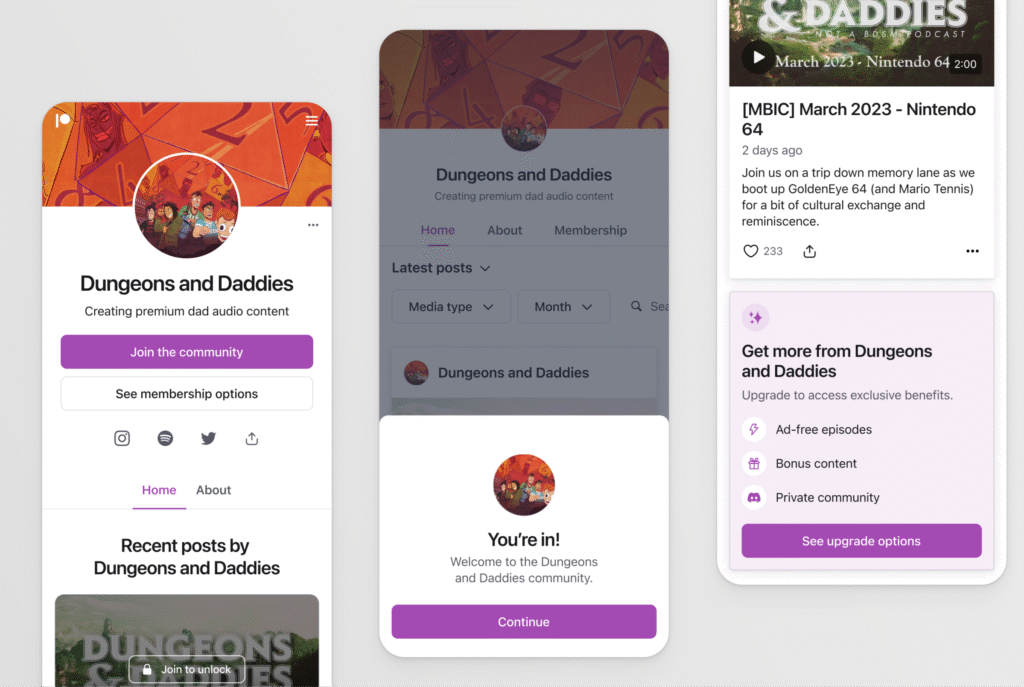Thinking about how to make money on Patreon by sharing your creative work online? You’re not alone—thousands of creators now earn up to $240,000/month by offering fans exclusive content through simple, recurring subscriptions.
This guide will teach you how Patreon works in 2025, how top creators build income, and how you can start earning from your content—even with a small audience.
You’ll walk away knowing the exact steps to launch your page, grow subscribers, and build a reliable stream of monthly income.
Key Takeaways
- Earn reliable monthly income from fans: Learn how to turn your creative content into recurring earnings with subscription tiers.
- Understand how top creators make bank: Real-life case studies show how podcasters, artists, and educators hit 5- and 6-figure incomes.
- Use platform tools to grow faster: Leverage new features like free trials, subscription gifting, and automated social sharing to boost patron count.
- Structure your offers with value: Find the perfect tier setup for your niche and learn how to price rewards effectively.
- Actionable steps to success: Get a complete roadmap from zero to monetized creator—even if you’re just starting out.
How to Make Money on Patreon?
In 2025, Patreon has introduced new tools that lower the barrier to entry, like subscription gifting, limited-time free trials, and discounted offers for new patrons. These help creators grow without needing viral reach.
Unlike platforms based on ad revenue or algorithms, Patreon rewards consistency and connection. You don’t need a massive audience—just loyal supporters willing to pay for extra value.
Still, success on Patreon requires effort. You need to deliver consistent, quality content, engage with your patrons, and promote your page. Treat it like a business, and it will pay like one.
What’s most encouraging is that creators in all niches—art, comedy, podcasts, gaming—are earning substantial monthly income with audiences under 1,000.
What do you need to get started?
Getting started on Patreon is easy. All you need is:
- A free Patreon creator account
- A way to accept payments (PayPal or Stripe)
- A few exclusive content ideas
- A platform (like YouTube, Instagram, email list) to send traffic from
You don’t need a huge following—just an audience that trusts you and sees the value in your work.
How much money can you make on Patreon?
Earnings vary, but most creators start making between $500 and $2,500/month after building just 100–300 loyal patrons. For example, Therapy for Black Girls earns $2,000/month with two affordable tiers and community access. Meanwhile, The Yard, a comedy podcast, earns $242,000/month with 37,000+ subscribers by offering bonus shows, exclusive Discord chats, and merch discounts.
Creators who clearly define their tiers and build real community see the fastest revenue growth.
14 Proven Strategies to Make Money on Patreon
Whether you’re a creator nurturing a loyal fanbase or a brand launching memberships, these 14 proven strategies show how to make money on Patreon with tiers, perks, and community—so you can turn consistent support into scalable, recurring revenue.
1. Offer Exclusive Content
One of the most powerful ways to make money on Patreon is by offering exclusive content your audience can’t find anywhere else. This can include bonus podcast episodes, behind-the-scenes videos, downloadable art, exclusive blog posts, or early access to public content.
The exclusivity creates a sense of VIP access, making fans feel more connected and valued. Whether you’re a writer, gamer, educator, or artist, the key is to provide extra value—not necessarily more content, but something unique that deepens the relationship.
This strategy works particularly well for creators already publishing publicly on platforms like YouTube, Instagram, or Substack. You tease free content and drive the most engaged followers to Patreon for the “premium” experience. Many creators find that even a $3/month tier can add up quickly when built around exclusivity.
How to Offer Exclusive Content on Patreon?
- Brainstorm content ideas fans already love (e.g., Q&As, vlogs, guides)
- Decide what content you’ll lock behind paywalls
- Create a publishing schedule for exclusive releases
- Set up content access by tier inside Patreon
- Use scheduling tools to automate posts
- Promote exclusive perks on all social platforms
- Mention upcoming exclusives in your free content
- Use FOMO to increase conversions (“Only on Patreon!”)
Quick tip: Keep your exclusives consistent, but small—one extra post per week is plenty to grow revenue.
2. Launch Tiered Memberships

Tiered memberships allow you to offer multiple price points for fans with different budgets and interests. Each tier gives increasing value—helping you earn more per patron and keep higher-paying members happy.
For example, a creator might offer:
- $3/month – early content access
- $7/month – bonus content + Discord access
- $15/month – live Q&As or behind-the-scenes extras
Successful creators use tiers to reward loyalty while gently encouraging fans to upgrade. You can also add time-limited bonuses or discounted trials (a new 2024 feature) to increase sign-ups.
In 2025, tier optimization is one of the highest-converting strategies on Patreon. It’s simple to set up, scalable, and supports both hobbyists and professionals.
How to Launch Tiered Memberships on Patreon?
- Decide on 2–4 reward levels
- Name your tiers with personality (e.g., “Super Fan,” “Backstage Pass”)
- Assign content access or perks to each tier
- Clearly describe tier benefits on your page
- Add images or emojis to make tiers visually appealing
- Set clear expectations on content delivery
- Test pricing: start low, then add higher tiers
- Use exclusive trial links to attract early subscribers
Quick tip: Avoid overpromising—offer scalable perks that won’t burn you out.
3. Create Bonus Podcast Episodes
Podcasting is the most lucrative niche on Patreon right now. In fact, over $472 million/year is generated by podcasters alone. Offering bonus episodes, ad-free versions, and early releases gives listeners a reason to pay monthly.
This method works because it builds on content fans already love. Many successful podcasters host free shows publicly, then offer premium extras—like deeper dives, “after dark” chats, or listener Q&As—on Patreon.
One standout example is RedHanded, a true crime podcast earning $59,000/month from their exclusive content strategy. They have three tiers ($4, $8, and $18) that unlock bonus episodes and exclusive back catalogs.
How to Create Bonus Podcast Episodes
- Decide what format fits your brand (Q&A, BTS, extra stories)
- Record new bonus content separately
- Upload audio directly to Patreon or use RSS integrations
- Make episodes ad-free or longer for added value
- Announce new bonuses via email or social
- Use teaser clips on free platforms
- Bundle with other perks (e.g., merch discounts)
Quick tip: Keep bonus episodes shorter—15–30 minutes makes it manageable for you and special for fans.
4. Offer Digital Downloads
Offering digital goods like wallpapers, printables, templates, music files, or PDFs is another smart way to boost your earnings. These are great one-time deliverables that require zero ongoing maintenance once created.
Art and design creators especially thrive here. You can use Patreon’s Commerce feature (5% fee) to sell standalone digital items or bundle them into higher-tier rewards.
Fans love tangible bonuses they can use offline, and it adds an eCommerce-like dimension to your membership. Educational creators also do well by offering downloadable workbooks or lesson slides.
How to Offer Digital Downloads on Patreon?
- Decide what file types make sense for your audience
- Create a bundle (e.g., 3 wallpapers/month)
- Upload files to your Patreon posts or member vault
- Add visuals to your reward tiers
- Set up automatic delivery for new signups
- Promote downloads as “instant bonuses”
- Update content monthly to keep it fresh
Quick tip: Watermark your work or zip folders to prevent free sharing or piracy.
5. Host Live Events & Q&As

Live streams and Q&A sessions are fantastic for building deep connections—and increasing monthly earnings. They also take minimal effort compared to editing long-form content.
Creators in niches like education, coaching, comedy, or art often host:
- Monthly livestreams
- Member-only Zoom workshops
- Q&A office hours
- “Ask me anything” chats
These can be offered in higher tiers ($10+) as a premium access reward. Plus, it gives fans a way to interact directly with you—which keeps them loyal long-term.
How to Host Live Events on Patreon?
- Pick your platform: Zoom, YouTube Live, Streamyard, Discord
- Announce event dates at least 1 week in advance
- Add RSVP or reminder options
- Gate entry with tier-based access
- Include Q&A or live demos to increase engagement
- Record sessions and upload for replay access
- Post highlights or behind-the-scenes afterward
Quick tip: Stick to a schedule—monthly events create urgency and habit.
6. Offer Early Access to Content
Giving patrons a sneak peek before the public gets access is one of the easiest low-effort perks you can offer. Whether you make videos, blog posts, podcasts, or illustrations—early access creates a VIP feel.
This is perfect for creators who already publish regularly. Just shift your schedule to share content 3–7 days early with paid subscribers. It’s also a smart upsell tactic for your lowest tier ($3–$5/month).
Even better, fans who are excited about your content will pay just to see it first.
How to Offer Early Access on Patreon?
- Decide how many days early your patrons will get access
- Upload content first to Patreon
- Add “early access” labels to posts
- Promote new posts with a countdown
- Send email or Discord reminders to members
- Schedule public content after Patreon release
- Include this perk in your lowest tier
Quick tip: Use teaser images and “coming soon” language to create excitement and urgency.
7. Run Discord Communities
A private Discord server is one of the most valuable perks you can offer—and it encourages community-led growth.
Discord gives your patrons 24/7 access to you, your content, and other like-minded fans. You can set up tiered access, special badges, or AMA events right inside your server.
This is especially powerful for educators, gamers, coaches, or fandom creators.
How to Run a Discord Server with Patreon?
- Connect Patreon to Discord via settings
- Set up private channels for paid members
- Assign roles based on tier levels
- Create community guidelines and post them
- Offer live chats, feedback sessions, or group challenges
- Promote your server as a key perk in all tiers
- Use bots to automate tier permissions
Quick tip: Add your Discord link inside every Patreon welcome message.
8. Sell Digital Courses or Trainings

Many educators and professionals on Patreon create mini-courses, training libraries, or private lessons as high-ticket rewards. This method works especially well if you teach skills like business, design, writing, or marketing.
You can gate courses behind a $25–$50/month tier or break lessons into modules and release them weekly. Some creators even use Patreon as their exclusive course platform.
How to Sell Digital Courses on Patreon?
- Choose a course topic tied to your niche
- Outline lessons and break them into small modules
- Deliver via PDFs, videos, or slides
- Post 1–2 modules per week to Patreon
- Gate access with a premium tier
- Add quizzes or feedback forms
- Promote the course on your blog or YouTube
Quick tip: Repurpose past livestreams or tutorials into course content.
9. Sell Behind-the-Scenes Access
Fans love seeing how the sausage gets made. Sharing your creative process—like sketching, writing drafts, blooper reels, or recording setups—gives patrons a sense of intimacy. These can be uploaded as bonus posts, video snippets, or “studio day” livestreams. Even low-effort uploads (like a voice note or time-lapse) help deepen loyalty and give patrons a reason to stay subscribed. This strategy works especially well for creators who already document their process on Instagram or TikTok.
Quick tip: Post quick “making of” clips directly from your phone—don’t over-edit behind-the-scenes content.
10. Offer Personalized Shoutouts
Offering shoutouts on your podcast, blog, or videos is a fun, easy perk—especially for fans who love public recognition. You can set a special tier ($10–$15/month) where patrons receive a shoutout once per month or after 3 months subscribed. This works well for entertainers, educators, and podcasters with a dedicated audience. It’s also great for building loyalty and incentivizing long-term memberships.
Quick tip: Use automation to track who’s eligible each month and keep things stress-free.
11. Give Patron-Only Polls & Content Votes
Letting patrons vote on what content you create makes them feel involved. You can ask them to choose topics, characters, Q&A questions, or content formats. This works well in creative niches like writing, gaming, or podcasting. It increases engagement and reduces content creation guesswork. Plus, it gives paying members more control—strengthening their bond with your brand.
Quick tip: Use voting results as teaser content to generate interest from non-paying followers.
12. Sell Merch Exclusives or Discounts

Physical rewards can be risky for beginners, but exclusive merch or discount codes are low-risk options when managed smartly. Platforms like Printful or Teespring can integrate with Patreon or be used manually. Consider a $15–$25 tier where patrons get a T-shirt, sticker pack, or mug after 3 months. You can also offer rotating discounts or merch drops as retention perks.
Quick tip: Only offer physical rewards to long-term patrons to keep shipping costs under control.
13. Gate Access to a Private Newsletter
If you write long-form content or teach, a private email newsletter is a great incentive. You can create premium editions with added analysis, resources, or updates and gate them behind a low-tier ($3–$5/month).
Tools like ConvertKit or Substack integrate with Patreon to automate delivery. This is especially effective for niche educators or writers.
Quick tip: Tease premium newsletter snippets in your free content to draw subscribers in.
14. Host Digital Workshops or Classes

Creators in coaching, fitness, wellness, or business niches can offer monthly workshops or mini-classes on Patreon. These can be hosted on Zoom and archived in a content library.
It’s an effective way to charge $25–$50/month for deeper learning while offering real-time access. This strategy works best when combined with a private Discord or Q&A tier.
Quick tip: Offer replays to make time zones and scheduling easier for global patrons.
15. Provide Downloadable Templates or Tools
If you’re a designer, marketer, business coach, or productivity expert, you can earn by offering templates, trackers, swipe files, or spreadsheets.
You don’t need to update them every month—just create a library of digital assets and lock it behind a $7–$15/month tier. This works particularly well with business, marketing, or digital productivity niches.
Quick tip: Bundle 3–5 related tools into “packs” to increase perceived value.
16. Share Weekly “Office Hours” or Coaching Access
Offer patrons the chance to ask for advice, submit feedback, or get reviews during weekly “office hours.” You can do this through email, Discord chat, or a monthly form.
This is highly valuable for creators who teach or coach in any capacity. It builds long-term trust and justifies mid-to-high tier pricing.
Quick tip: Use recurring form submissions to streamline questions ahead of time.
Step-by-Step Guide to Make Money on Patreon
Getting started on Patreon in 2025 is easier than ever—but succeeding requires a strategic approach. Whether you’re a creator with zero followers or someone with a small online community, here’s your complete roadmap to go from setup to sustainable monthly income.
Step 1: Create Your Patreon Account
Start by signing up for a free creator account on Patreon.com. Choose your plan type—most creators use the Pro plan (8% fee), which includes core membership tools. Link your PayPal or Stripe for payouts and complete your creator profile, including your bio, photo, and cover image.
Quick setup tip: Don’t overthink design—your content is what keeps patrons subscribed.
Step 2: Define Your Niche and Ideal Patron
Next, get specific about who you serve. Are you a podcaster, artist, educator, or entertainer? Defining your niche helps you determine what kind of content, perks, and tone your Patreon should have. Think about what your audience already loves—and what they’d happily pay for more of.
Quick tip: Your ideal patron is your biggest fan, not a stranger—build for them.
Step 3: Choose Your Monetization Strategy
Decide what kind of value you’ll offer: exclusive content, early access, bonus episodes, live sessions, or digital downloads. The best approach? Start small. Offer 2–3 core perks and expand as you grow. This ensures sustainability and scalability.
Step 4: Set Up 2–3 Tier Levels
Structure your membership using 2 to 3 price tiers, with clear and increasing value. A typical setup is $3, $7, and $15/month. Use friendly tier names, visuals, and short descriptions. You can always add more tiers later.
Quick tip: Make sure each tier delivers more perceived value than its price.
Step 5: Create and Upload Your First Content
Before promoting your Patreon, upload your first few posts. These might be an intro video, a behind-the-scenes vlog, a download bundle, or an exclusive Q&A. This ensures new patrons see immediate value.
Quick tip: Preloading content boosts trust and increases early conversions.
Step 6: Promote Your Patreon Across All Channels
Now it’s time to launch. Share your Patreon on YouTube, Instagram, email lists, or podcasts. Use urgency (limited-time discount or bonus) to drive traffic. Mention your Patreon in your bio, videos, and link-in-bio tools.
Step 7: Use Automation & Tools to Save Time
Connect tools like IFTTT, ConvertKit, or Discord to automate posts, messages, and perks. This helps scale while staying consistent. Patreon now supports native integrations with major platforms, making your workflow smoother than ever.
Quick tip: Automate welcome messages, content drops, and Discord roles from day one.
Step 8: Engage With and Retain Your Patrons
Now that you’re live, focus on community building. Respond to comments, ask for feedback, and consistently deliver value. Monthly updates, bonus drops, and live chats keep patrons subscribed. Retention is key to growing predictable income.
Tips to Increase Patreon Revenue in 2025
To grow your monthly Patreon income, you’ll need more than just great content—you need a clear revenue strategy. One proven tip is tier optimization. Many creators succeed with just 2–3 tiers, but test your pricing. For example, creators earning over $50K/month often use $5, $10, and $25 tiers that scale rewards and community access.
Another tip? Reward longevity. Offer milestone perks like bonus content after 3 months, or discounted merch at 6 months. These boost retention and create long-term value.
Also, keep a strong call to action across your free platforms—mention your Patreon regularly in podcasts, videos, and blog posts. Drive urgency by offering time-limited perks, exclusive first-come rewards, or early access drops.
Quick tip: Increase revenue by upselling mid-tier patrons during launches with “founder perks” or bundled bonus drops.
Best AI Tools for Making Money on Patreon
Using the right AI tools can drastically reduce your workload and increase patron satisfaction. ChatGPT and Jasper are popular for writing monthly newsletter updates, creating captions, or brainstorming reward ideas. Visual creators love Canva’s AI Magic Studio for fast content creation—ideal for exclusive Patreon posts.
Voice creators can use Descript to transcribe and edit bonus podcast episodes or live replays. Meanwhile, Repurpose.io and IFTTT help automate content distribution to Twitter, Instagram, or YouTube—saving hours every week.
Use AI to batch schedule content, generate tier perks, or respond to FAQs. This is especially useful if you’re balancing content creation with other business or freelance work.
Quick tip: Use ChatGPT to brainstorm monthly theme ideas and schedule your Patreon posts 2–4 weeks ahead.
Best Affiliate Platforms for Patreon Creators
Combining affiliate marketing with your Patreon is a powerful way to boost your income. For educators, creators, and niche influencers, platforms like ShareASale, Impact, and PartnerStack offer access to high-converting software and service-based affiliate programs.
If you run a productivity or creator-focused Patreon, promoting tools like Notion, ConvertKit, or Canva can easily add $100–$500/month in affiliate commissions. Be sure to use affiliate links in gated content, templates, or private newsletters.
You can also use affiliate tools to enhance your rewards. For example, offer members curated product lists with your affiliate links as part of a higher tier. This lets you earn extra without creating more content.
Quick tip: Track affiliate clicks with tools like Bit.ly or Pretty Links and focus on promoting just 2–3 core offers.
Best Marketing Tools for Monetizing on Patreon
Marketing your Patreon requires smart tools that streamline your outreach without adding stress. Start with ConvertKit or MailerLite for email marketing. These platforms make it easy to segment lists, deliver exclusive perks, and onboard new subscribers with automated welcome flows.
Next, use Buffer or Later for scheduling social posts that highlight new Patreon rewards. Pair these with teaser images made in Canva to create polished, engaging promo content.
For real-time engagement, link your Discord server to your Patreon tiers. It’s perfect for creators offering community-based perks, live chats, or private content drops.
Finally, use Patreon’s native analytics to see what content performs best, then double down on those formats.
Quick tip: Schedule 1 promo post per week across platforms and build a monthly “launch moment” around a new reward.
Conclusion
In 2025, learning how to make money on Patreon doesn’t require a huge audience—just a smart, intentional strategy. With the right niche, tier setup, and promotional plan, creators are earning between $2,000 and $240,000/month across industries.
Whether you’re offering bonus podcasts, exclusive content, or community access, your success comes from consistency and connection. Start simple, promote confidently, and scale with tools that keep you focused.
There’s never been a better time to build a sustainable income doing what you love.
Frequently Asked Questions (FAQs)
Do I need a large following to make money on Patreon?
No. Many creators earn a steady income with fewer than 500 followers. What matters more is having an engaged, loyal audience—even if it’s small.
How much money can a beginner realistically make?
Most new creators make $100–$500/month within their first few months. With consistent promotion and good tier structure, scaling to $1,000–$2,000/month is realistic.
How often do I need to post on Patreon?
At least once a week is ideal. Some creators post 2–3 times monthly with high-value content. Consistency builds trust and increases retention.
What kind of content works best on Patreon?
Bonus episodes, exclusive videos, early access, downloadable tools, and community perks perform best. Match your perks to your niche and audience.
Can I use Patreon if I already monetize on YouTube or Substack?
Yes! Many creators use Patreon to supplement YouTube, podcasts, and newsletters by offering “premium” versions of their content.
What are the best tools for managing my Patreon?
Tools like IFTTT, ConvertKit, Descript, and Canva can help automate and streamline your content and communication.
How do I reduce churn and keep patrons subscribed?
Offer value-packed tiers, deliver content consistently, reward longevity (3- or 6-month bonuses), and engage via Discord or email.
Is Patreon still worth it in 2025?
Absolutely. With new tools like free trials, gifting, and promo codes, Patreon offers more ways than ever to build recurring revenue.



